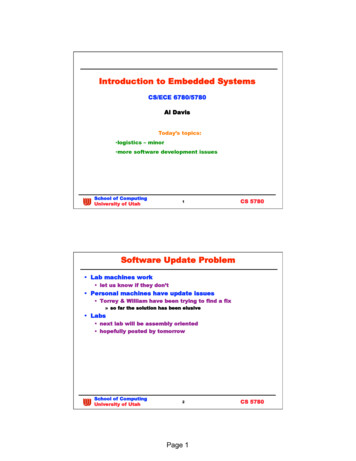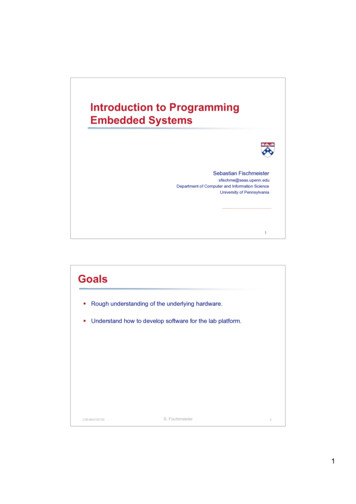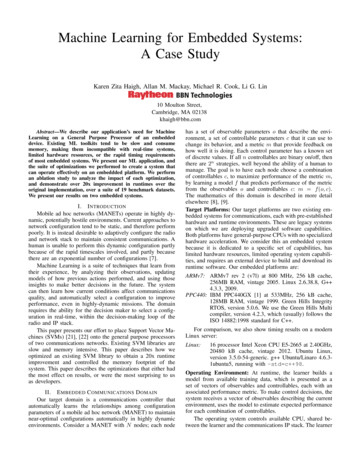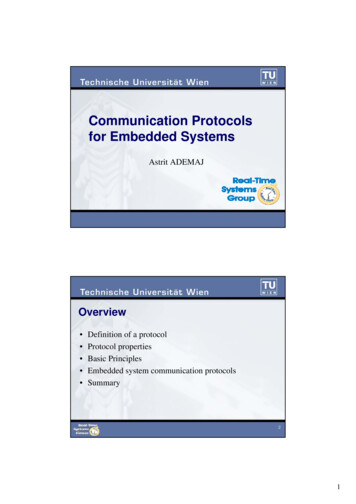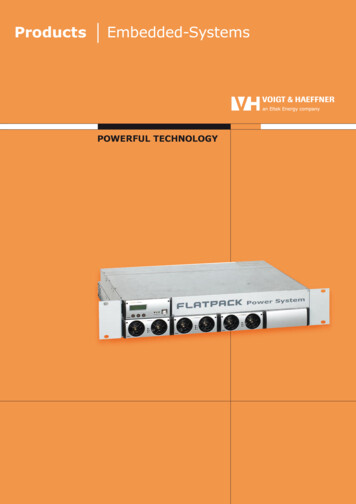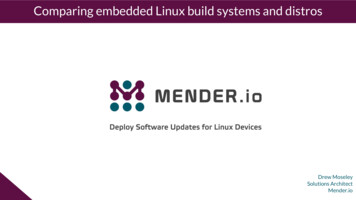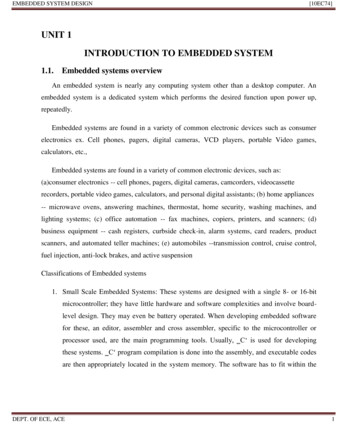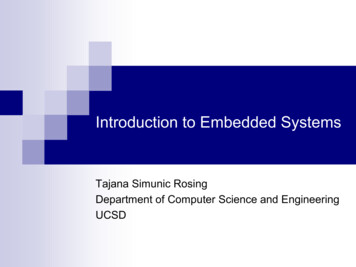
Transcription
Introduction to Embedded SystemsTajana Simunic RosingDepartment of Computer Science and EngineeringUCSD
Welcome! Instructor: Tajana Simunic Rosing Office Hours: Office Location: CSE 2118Sheila Manalo Email: shmanalo@ucsd.edu Phone: (858) 534-8873 Office: CSE 2272TAs: T 11:30-12:30pm, Th 5-6pmAdmin: Email: tajana-at-ucsd.edu; put WES in subject lineJug Venkatesh: Wed 6-7pm, Th 6-7pmAnkit Baid: Mon 6-7pm, Tue 6-7pmLocation: CSE B260AGrades: http://ted.ucsd.eduCourse website: ussion board: https://piazza.com/#winter2013/wes237a
Course Objectives Develop an understanding of the technologiesbehind the embedded computing systems technologycapabilities and limitations of the hardware,software components methods to evaluate design tradeoffs between differenttechnology choices. design methodologies Overview of a few hot research topics in ESFor more details, see the schedule on the webpage
Course Requirements No official graduate course as prerequisiteKnowledge Skills Ability to program (linux, C, C , Android)Ability to look up references and track down pubs (Xplore etc)Ability to communicate your ideas (demos, reports)Initiative Digital hardware, introductory electrical circuits concepts, computerarchitecture (ISA, organization), programming & systemsprogrammingOpen-ended problems with no single answer requiring thinking andresearchInterest
Textbook & Assigned Reading Required text: ByPeter Marwedel 2nd edition, Springer 2011 A set of papers will be required reading willrelate to the core topic of that class you are expected to read it BEFORE the class In addition I will give pointers to papers andweb resources
Reference books “Embedded, Everywhere: A Research Agenda for Networked Systems of Embedded Computers,”National Research Council. http://www.nap.edu/books/0309075688/html/John A. Stankovic and Kirthi Ramamritham, "Hard Real-Time Systems," IEEE Computer SocietyPress.G.D. Micheli, W. Wolf, R. Ernst, “Readings in Hardware/Software Co-Design,” Morgan Kaufman.S.A. Edwards, “Languages for Digital Embedded Systems,” Kluwer, 2000.R. Melhem and R. Graybill, “Power Aware Computing,” Plenum, 2002.M. Pedram and J. Rabaey, “Power Aware Design Methodologies,” Kluwer, 2002.Bruce Douglass, "Real-Time UML - Developing Efficient Objects for Embedded Systems," AddisonWesley, 1998.Hermann Kopetz, "Real-Time Systems : Design Principles for Distributed Embedded Applications,"Kluwer, 1997.Hassan Gomaa, "Software Design Methods for Concurrent and Real-Time Systems," AddisonWesley, 1993.P. Lapsley, J. Bier, A. Shoham, and E.A. Lee, “DSP Processor Fundamentals: Architectures andFeatures,” Berkeley Design technology Inc,, 2001.R. Gupta, "Co-synthesis of Hardware & Software for Embedded Systems," Kluwer, 1995.Felice Balarin, Massimiliano Chiodo, and Paolo Giusto, "Hardware-Software Co-Design ofEmbedded Systems : The Polis Approach," Kluwer, 1997.Jean J. Labrosse, "Embedded Systems Building Blocks : Complete And Ready To Use Modules InC ," R&D Publishing, 1995.Jean J. Labrosse, "uC / OS : The Real Time Kernel," R&D Publishing, 1992.
Embedded Systems on the Web Berkeley Design technology, Inc.: http://www.bdti.comEE Times Magazine: http://www.eet.com/Linux Devices: http://www.linuxdevices.comEmbedded Linux Journal: http://embedded.linuxjournal.comEmbedded.com: http://www.embedded.com/ Circuit Cellar: http://www.circuitcellar.com/Electronic Design Magazine: http://www.planetee.com/ed/Electronic Engineering e.htmlIntegrated System Design Magazine: http://www.isdmag.com/Sensors Magazine: http://www.sensorsmag.comEmbedded Systems Tutorial: http://www.learn-c.com/Collections of embedded systems resources Embedded Systems Programming magazinehttp://www.ece.utexas.edu/ xas.edu/ bevans/courses/realtime/resources.htmlNewsgroups comp.arch.embedded, comp.cad.cadence, comp.cad.synthesis, comp.dsp,comp.realtime, comp.software-eng, comp.speech, and sci.electronics.cad
Embedded Systems Courses Alberto Sangiovanni-Vincentelli @ Berkeley EE 249: Design of Embedded Systems: Models, Validation, andSynthesis Brian Evans @ U.T. Austin EE382C-9 Embedded Software Systems http://ptolemy.eecs.berkeley.edu/ eal/ee290n/index.htmlMani Srivastava @ UCLA EE202A: Embedded and Real Time Systems http://www.ece.utexas.edu/ bevans/courses/ee382c/index.htmlEdward Lee @ Berkeley EE290N: Specification and Modeling of Reactive Real-Time Systems http://www-cad.eecs.berkeley.edu/ ses/ee202a/2003f/Bruce R. Land @ CMU EE476: Designing with Microcontrollers http://instruct1.cit.cornell.edu/courses/ee476
Conferences and Journals Conferences & Workshops ACM/IEE DACIEEE ICCADIEEE RTSSACM ISLPEDIEEE CODES ISSSCASESMany others Journals & Magazines ACM Transactions on Design Automation of Electronic SystemsACM Transactions on Embedded Computing SystemsIEEE Transactions on Computer-Aided DesignIEEE Transactions on VLSI DesignIEEE Design and Test of ComputersIEEE Transactions on ComputersJournal of Computer and Software EngineeringJournal on Embedded Systems
Class TopicsHardware componentsHardwareVerification and Validation10
WES class scheduleDay 1: Introduction and ModelingProject part #1 assignedChapter 1, Chapter 2 Sec. 2.1 to 2.6Edwards et al.:” Design of Embedded Systems: Formal Models, Validation and Synthesis”Murata:”Petri nets: Properties, Analysis and Applications” p. 541-553, Sec. VIIIDay 2: Modeling, Timing, and SchedulingQuiz #1; Project part #1 due, part #2 assignedChapter 2 Sec. 2.7 to 2.10, Chapter 6 Sec. 6.1 to 6.2Lee et al. “Static scheduling of synchronous DF programs for DPS”Benveniste et al.”The Synchronous Languages 12yrs Later”Raynal, Singhal ”Logical time: A way to capture causality in distributed systems”Day 3: Scheduling, RTOS and SoftwareQuiz #2; Project part #2 due, part #3 assignedChapter 6 section 6.2, Chapter 4, Chapter 7 Sec. 7.1 to 7.3Sha et al.”Generalized rate-monotonic scheduling theory ”I.C. Bertolotti: "Real-Time embedded operating systems: standards and perspectives chap. 11.1,2,4,5Day 4: Embedded Hardware, Power, Energy, and ThermalQuiz #3;Chapter 3 Sec. 3.3 to 3.4, Chapter 5, Chapter 7 Sec. 7.4"Moyer: “Low-power design for embedded processors”Wolf et al. ”Memory System Optimization of Embedded Software”L. Benini, A. Bogliolo, and G. De Micheli. "A survey of design techniques for system-level dynamic power management"G. Dhiman, T. Simunic Rosing, "Using online learning for system level power management"Day 5: Sensors, Actuators, I/O, and HW/SW Co-designQuiz #4; Final project demo and report dueChapter 3 Sec. 3.1, 3.2, 3.5, 3.6, Chapter 6 Sec. 6.3 to 6.4,Culler, Estrin, “Overview of sensor networks”Hard Real-time Communication in Multiple-Access NetworksDe Micheli, Gupta: “Hardware/Software Co-Design”03/23/2012 Final – in class, 1hr 20minNote: Subject to change
WES Course Daily Timeline :30-3pm3-3:30pm3:30-5:00Review, Q&AQuizLectureTAs: sample problemsLunchLectureTAs: sample problemsTAs: Project and/or additional lecture
Course Grading Class participation: 4% Come prepared to discuss the assigned paper(s)Quizzes ( 4): 16%Embedded systems project 40%Tools for modeling of embedded systems, cross-compile andanalyze energy/performance of various mobile apps, make kernelmore energy efficient Three parts: Individual: Part 1: 5%, Part 2: 20% of the total project gradeTeam of two: Part 3: 75% of the total project gradeFinal exam: 40%
Embedded Systems on the Web Berkeley Design technology, Inc.: http://www.bdti.comEE Times Magazine: http://www.eet.com/Linux Devices: http://www.linuxdevices.comEmbedded Linux Journal: http://embedded.linuxjournal.comEmbedded.com: http://www.embedded.com/ Circuit Cellar: http://www.circuitcellar.com/Electronic Design Magazine: http://www.planetee.com/ed/Electronic Engineering e.htmlIntegrated System Design Magazine: http://www.isdmag.com/Sensors Magazine: http://www.sensorsmag.comEmbedded Systems Tutorial: http://www.learn-c.com/Collections of embedded systems resources Embedded Systems Programming magazinehttp://www.ece.utexas.edu/ xas.edu/ bevans/courses/realtime/resources.htmlNewsgroups comp.arch.embedded, comp.cad.cadence, comp.cad.synthesis, comp.dsp,comp.realtime, comp.software-eng, comp.speech, and sci.electronics.cad
Embedded Systems Courses Alberto Sangiovanni-Vincentelli @ Berkeley EE 249: Design of Embedded Systems: Models, Validation, andSynthesis Brian Evans @ U.T. Austin EE382C-9 Embedded Software Systems http://ptolemy.eecs.berkeley.edu/ eal/ee290n/index.htmlMani Srivastava @ UCLA EE202A: Embedded and Real Time Systems http://www.ece.utexas.edu/ bevans/courses/ee382c/index.htmlEdward Lee @ Berkeley EE290N: Specification and Modeling of Reactive Real-Time Systems http://www-cad.eecs.berkeley.edu/ ses/ee202a/2003f/Bruce R. Land @ CMU EE476: Designing with Microcontrollers http://instruct1.cit.cornell.edu/courses/ee476
Conferences and Journals Conferences & Workshops ACM/IEE DACIEEE ICCADIEEE RTSSACM ISLPEDIEEE CODES ISSSCASESMany others Journals & Magazines ACM Transactions on Design Automation of Electronic SystemsACM Transactions on Embedded Computing SystemsIEEE Transactions on Computer-Aided DesignIEEE Transactions on VLSI DesignIEEE Design and Test of ComputersIEEE Transactions on ComputersJournal of Computer and Software EngineeringJournal on Embedded Systems
What are embeddedsystems and why should we care?
What areembedded systems? Systems which use computation to perform aspecific functionembedded within a larger device and environmentHeterogeneous & reactive to environmentMain reason for buying is not information processing
Embedded processor market Processors strongly affect SW development – keepstheir prices highOnly 2% of processors drive PCs!ARM sells 3x more CPUs then Intel sells Pentiums79% of all high-end processors are used in embeddedsystemsSource: EETimes
Tied to advances in semiconductors A typical chip in near future 1-10 GHz, 100-1000 MOP/sq mm, 10-100 MIPS/mWCost is almost independent of functionality10,000 units/wafer, 20K wafers/month 5 per part Processor, MEMS, Networking, Wireless, Memory But it takes 20M to build one today, going to 50 MSo there is a strong incentive to port your application,system, box to the “chip”Source: RG UCSD
Trends in Embedded Systems Increasing code sizeaverage code size: 16-64KB in 1992, 64K-512KB in 1996 migration from hand (assembly) coding to high-level languages Reuse of hardware and software componentsprocessors (micro-controllers, DSPs) software components (drivers) Increasing integration and system complexityintegration of RF, DSP, network interfaces 32-bit processors, IO processors (I2O) Structured design and composition methods are essential.Source: RG UCSD
Characteristics of Embedded Systems Application specificEfficient Dependable Analog and digitalDistributed sensors & actuatorsHybrid Soft vs. hardReactive - connected to physical environment Reliability, maintainability, availability, safety, securityReal-time constraints energy, code size, run-time, weight, costComposability, scalability, dependabilityDedicated user interfacesembeddedembeddedreal-timereal-time
Applications Medical systemse.g. “artificial eye” e.g. “micro-needles”www.dobelle.comSource: ASV UCB
On-chip Chemistryholes for fluidiccontactelectromagnet areaunderneath devicearm 14 mmarm3arm 2holes for electricalcontact1 mm
Pedometer Obvious computer work: Countsteps Keep time Averages etc. Hard computer work: Actuallyidentify when astep is taken Sensor feels motion ofdevice, not of user feet Jakob Engblom
If you want to play Lego mindstormsrobotics kit Standard controller 8-bit processor 64 kB of memory Electronicsto interfaceto motors and sensors Good way to learnembedded systems Jakob Engblom
Mobile phones Multiprocessor 8-bit/32-bit for UI DSP for signals 32-bit in IR port 32-bit in Bluetooth8-100 MB of memoryAll custom chipsPower consumption &battery life depends onsoftware Jakob Engblom
Inside the PC Custom processors Graphics, sound32-bit processors IR,Bluetooth Network, WLAN Hard disk RAID controllers 8-bit processors USB Keyboard,mouse Jakob Engblom
Mobile base station Massive signal processing Severalprocessing tasks perconnected mobile phone Based on DSPs Standardor custom 100s of processors Jakob Engblom
Telecom Switch Rack-based Controlcards IO cards DSP cards . Optical & copperconnectionsDigital & analogsignals Jakob Engblom
Smart Welding Machine Electronics control voltage &speed of wire feedAdjusts to operator kHzsample rate 1000s of decisions/second Perfect weld even for quiteclumsy operatorsEasier-to-use product, but noobvious computer Jakob Engblom
Cars Multiple processors networked together ( 100), wide variety of CPUs: Multiple networks 8-bit – door locks, lights, etc; 16-bit – most functions; 32-bit – engine control, airbagsBody, engine, telematics, media, safety90% of all innovations based on electronic systemsMore than 30% of cost is in electronics Jakob Engblom, ASV UCB
Source: ASV UCB
TransportationAmtrak Acela High Speed Train High speed tilting train service between Boston, New York, andWashington, D.C.Built by Bombardier, uses FT-10 free topology twisted pair channel tomonitor and control propulsion, power inverters, braking, fireprotection systems, ride stability, safety, and comfort.Source: Echelon
Building AutomationCoeur Déf
Introduction to Embedded Systems Tajana Simunic Rosing Department of Computer Science and Engineering UCSD . Welcome! Instructor: Tajana Simunic Rosing Email: tajana-at-ucsd.edu; put WES in subject line Office Hours: T 11:30-12:30pm, Th 5-6pm Office Location: CSE 2118 Admin: Sheila Manalo Email: shmanalo@ucsd.edu Phone: (858) 534-8873 Office: CSE 2272 TAs: Jug Venkatesh: Wed 6 Cited by: 1Publish Year: 2005Author: Peter Marwedel



